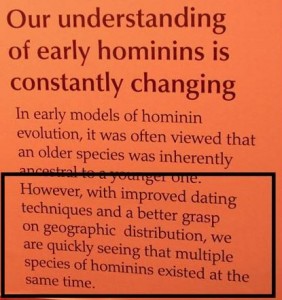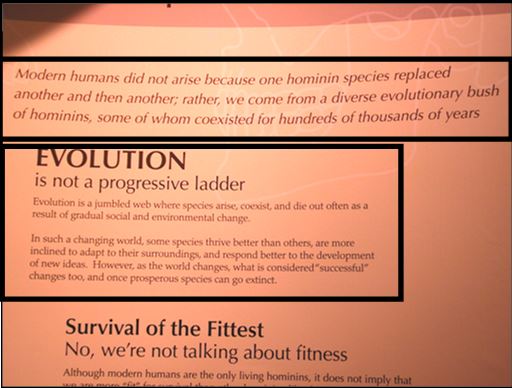Recently, while visiting the anthropology museum in Laramie, WY, I read and saw some very interesting exhibits. Most of what I read was not new, but exactly what the book of Genesis predicted …as I will explain later. The sign for the first display of interest read in part (pictured right and the content in the black box is printed below):
“H.rudolfensis, A. boisei, and H. erectus All lived at the same time and this means that one is not an ancestor of the others.”
We can read from an article in the Discover magazine, that they agree with the findings of the museum.
“Human evolution is bushy with branches that go nowhere. You don’t just have Australopithecus leading to Homo habilis leading to Homo erectus leading to Homo sapiens. This lineal idea is just kind of bogus. It was all very simple in the past, but it’s all wrong.”
– Anthropologist Russell Ciochon, University of Iowa, comments on new fossil finds. Discover, Jan 1996
We neither observe today, nor in the fossil record, the vertical macro-evolution (Darwinian evolution), which is one creature evolving into a completely different creature. There is no evidence of an evolutionary tree of life. What we do observe in nature is horizontal micro-evolution as described in Scripture.
As I listen to people, including scientists, they seem to have a misconception of what the Bible actually teaches. Many believe the Bible states that creatures do not change at all. But this is not the case. With a little studying of the Greek culture, we will see that some of the influential Greek philosophers taught this concept and it is usually called ‘the immutability of species.’
“Fundamental to natural selection is the idea of change by common descent. This implies that all living organisms are related to each other; for any two species, if we look back far enough we will find that they are descended from a common ancestor. This is a radically different view than Aristotle’s Great Chain of Being, in which each species is formed individually with its own purpose and place in nature and where no species evolves into a new species.”
http://www.iep.utm.edu/evolutio/
Some in the church made a great mistake when reading some of the false teachings of the Greeks into Scripture. So Darwin did not discredit the Bible, but those who incorporated the false philosophical wisdom of man into Scripture.
The question is …what does the Bible teach? God created kinds, or family types, to be ‘fruitful, multiply, and fill the earth.’ The original kinds would have contained a huge diversity of genetic information, thus giving them the ability to adapt to different and changing environments. God’s intent was not for the kinds to go extinct, but to survive and fill the earth, and this would be accomplished by speciation within a kind. Speciation is not vertical macro-evolution (Darwinian evolution), but is instead the Biblical, scientific, horizontal micro-evolution.
If a species did not have the genetic diversity to adapt to the ever-changing environments, they would probably go extinct. As we observe in some species today. If a given species still has the genetic diversity to adapt to the changing environment, that species can then change to survive in a new environment. As the Bible predicted, there would be a number of different kinds growing into diverse ‘bushes’ (instead of a tree) of species , where the specific makeup differs as the conditions change. One species would not be any more complex or superior to the other species, but just better adapted for the current conditions. The conditions will determine what species of a kind will fill what environment.
Since God created all the kinds in just two days, there would be a number of bushes existing at the same time.
As the Bible predicted, scientists do find evidence of man existing with his so called missing links.
“At the beginning of its time range, around 1.9 Mya, H. erectus coexisted in East Africa with several other early human species including Homo rudolfensis, Homo habilis, and Paranthropus boisei. Sometimes they were even found at the same fossil sites. At the end of its time range, around 143,000 years ago, it coexisted with Homo sapiens and possibly Homo floresiensis in Indonesia.”
http://humanorigins.si.edu/evidence/human-fossils/species/homo-erectus
As one studies the research on Homo erectus, one discovers he is only one of many variations of a human being. Some of his physical features are similar to modern day Australian aborigines and African groups.
“The skeleton of H. erectus was heavier, or “more robust,” than the average modern human skeleton. Body proportions vary greatly from individual to individual. “Turkana Boy” was tall and slender, like modern humans from the same area,…”
http://www.pbs.org/wgbh/evolution/humans/humankind/k.html
The Turkana Boy skeleton is regarded by many as a subhuman ancestor, but it is easy to see why even some evolutionists believe he is the same species as people today.
“From the neck down, the skeleton is virtually indistinguishable from that of a modern Kenyan bushman.”
http://creation.com/turkana-boy-getting-past-the-propaganda
There is also evidence of humans living at the same time as ‘Lucy.’ This topic will be discussed in a later article or you can search our website.
The conclusion from the evidence is, we never observe the vertical macro-evolutionary tree of one kind, or family type, of creature evolving into a completely different kind of creature. We do observe the horizontal, micro-evolution of Biblical bushes (species or speciation within a kind). Can we use the Bible as a guide to prevent us from making scientific mistakes? Yes, we can!
Rich Stepanek
If you would like to see if an AOI seminar is right for you, or you would like to help the work of Alpha Omega Institute, please visit our website events page or our donate page. Keep up to date with what AOI is doing. Thanks for your partnership.




